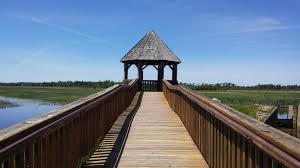There is no actual cache at this location. To claim this EarthCache, you must provide the answers to the questions at the end of the cache description.
Most people are familiar with the cattail or lily pad wetland found in areas with standing water, but wetlands can also be grassy meadows, shrubby fields, or mature forests. Many wetland areas have only a high ground water table and standing water may not be visible. Types of wetlands include deciduous swamps, wet meadows, emergent marshes, conifer swamps, wet prairies, shrub-scrub swamps, fens, and bogs.
Wetlands are a significant factor in the health and existence of other natural resources of the state, such as inland lakes, ground water, fisheries, wildlife, and the Great Lakes. Some of the benefits provided by wetlands are:
- Flood and storm control by absorption and storage of water.
- Wildlife habitat by providing breeding, nesting, and feeding grounds and cover for many forms of wildlife, waterfowl, including migratory waterfowl, and rare, threatened, or endangered wildlife species.
- Protection of underground water resources and recharging ground water supplies.
- Pollution treatment by serving as a biological and chemical oxidation basin.
- Erosion control by serving as a sedimentation area and filtering basin, absorbing silt and organic matter.
- Sources of nutrients in water food cycles and nursery grounds and sanctuaries for fish.
According to the U.S. Fish and Wildlife Service, Michigan has lost over 50% of its original wetlands, having been drained or filled, thereby making the protection of remaining wetlands that much more important.
One of the tools used to prevent a loss of wetlands is mitigation. The purpose of wetland mitigation, is the replacement of unavoidably lost wetland resources from road construction or land development, with created or restored wetlands, with the goal of replacing as fully as possible the functions of the lost wetland.
The Houghton Lake Flats were created in the mid 1960s as part of a mitigation project between Michigan DNR and the Michigan Department of Transportation when the US-27 freeway was built. The total area of the Flats is 770 acres. The North Unit is 380 acres and is managed as a shrub-scrub wetland. The South Unit is 390 acres and is managed as an emergent marsh.
 This site was chosen for mitigation due to its proximity of the wetlands being destroyed by the construction of US-27, a high water table, and having the same poorly drained histosols. Histosols are soils that are composed mainly of organic materials. They typically form in areas where poor drainage inhibits the decomposition of plant and animal remains, allowing these organic materials to accumulate over time. Histosols are often referred to as peats and mucks. Locally they were formed in the poorly drained outwash channel soils of the Grayling Outwash Plain, deposited when the Wisconsin Glacier receded about 14,000 years ago. The ability to manage the mitigation also allows for more of an open water percentage than many of the nearby marshes in the South Unit, and the locally rarer Scrub-shrub marsh type in the North Unit.
This site was chosen for mitigation due to its proximity of the wetlands being destroyed by the construction of US-27, a high water table, and having the same poorly drained histosols. Histosols are soils that are composed mainly of organic materials. They typically form in areas where poor drainage inhibits the decomposition of plant and animal remains, allowing these organic materials to accumulate over time. Histosols are often referred to as peats and mucks. Locally they were formed in the poorly drained outwash channel soils of the Grayling Outwash Plain, deposited when the Wisconsin Glacier receded about 14,000 years ago. The ability to manage the mitigation also allows for more of an open water percentage than many of the nearby marshes in the South Unit, and the locally rarer Scrub-shrub marsh type in the North Unit.
The posted coordinates take you to a handicap accessible elevated observation pavilion in the South Unit, where there are two informational signs that you will need to read in order to answer the following questions:
1) At the posted coordinates are two informational signs. One is titled "Osprey". What is the title of the other sign? This is the sign you will need to read to answer the next question.
2) According to the "other" sign, (a) what year was the South Unit first flooded, (b) what is the vegetation/open water mixture?
3) Looking out at the marsh, where do you think the majority of the organic material making up the histosols comes from? If it is winter and the marsh is frozen over, give your best guess and why.
4) In your own words, why was this area a good choice for mitigation? Across the road to the south is a natural emergent marsh for comparison.
To claim this cache as 'found', you must send a message to the CO with your answers.
Please do not post spoiler pictures!
Next to the parking area, there is a handicap accessible fishing platform.
The coordinates for the North Unit pump house are N 44° 23.631 W 084° 47.850, if you would like to see a scrub-shrub wetland.